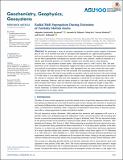| dc.contributor.author | Quintanilla Terminel, Alejandra | |
| dc.contributor.author | Dillman, Amanda M. | |
| dc.contributor.author | Pec, Matej | |
| dc.contributor.author | Diedrich, Garrett | |
| dc.contributor.author | Kohlstedt, David L. | |
| dc.date.accessioned | 2020-08-24T21:24:44Z | |
| dc.date.available | 2020-08-24T21:24:44Z | |
| dc.date.issued | 2019-05 | |
| dc.date.submitted | 2019-04 | |
| dc.identifier.issn | 1525-2027 | |
| dc.identifier.issn | 1525-2027 | |
| dc.identifier.uri | https://hdl.handle.net/1721.1/126781 | |
| dc.description.abstract | We performed a series of extrusion experiments on partially molten samples of forsterite plus 10 vol% of an anorthite-rich melt to investigate melt segregation in a pipe-extrusion geometry and test the predictions of two-phase flow theory with viscous anisotropy. The employed flow geometry has not been experimentally investigated for partially molten rocks; however, numerical solutions for a similar, pipe-Poiseuille geometry are available. Samples were extruded from a 6-mm diameter reservoir into a 2-mm diameter channel under a fixed normal stress at 1350°C and 0.1 MPa. The melt distribution in the channel was subsequently mapped with optical and backscattered electron microscopy and analyzed via quantitative image analysis. Melt segregated from the center toward the outer radius of the channel. The melt fraction at the wall increased with increasing extrusion duration and with increasing shear stress. The melt fraction profiles are parabolic with the melt fraction at the wall reaching 0.17–0.66, values 2 to 16 times higher than at the channel center. Segregation of melt toward the wall of the channel is consistent with base-state melt segregation as predicted by two-phase flow theory with viscous anisotropy. However, melt-rich sheets inclined at a low angle to the wall, which are anticipated from two-phase flow theory, were not observed, indicating that the compaction length is larger than the channel diameter. The results of our experiments are a test of two-phase flow theory that includes viscous anisotropy, an essential theoretical frame work needed for modeling large-scale melt migration and segregation in the upper mantle. | en_US |
| dc.description.sponsorship | National Science Foundation (Grant EAR‐1520647) | en_US |
| dc.language.iso | en | |
| dc.publisher | American Geophysical Union (AGU) | en_US |
| dc.relation.isversionof | http://dx.doi.org/10.1029/2018gc008168 | en_US |
| dc.rights | Article is made available in accordance with the publisher's policy and may be subject to US copyright law. Please refer to the publisher's site for terms of use. | en_US |
| dc.source | Prof. Pec via Chris Sherratt | en_US |
| dc.title | Radial Melt Segregation During Extrusion of Partially Molten Rocks | en_US |
| dc.type | Article | en_US |
| dc.identifier.citation | Quintanilla-Terminel, Alejandra et al. "Radial Melt Segregation During Extrusion of Partially Molten Rocks." Geochemistry, Geophysics, Geosystems 20, 6 (June 2019): 2985-2996 © 2019 American Geophysical Union | en_US |
| dc.contributor.department | Massachusetts Institute of Technology. Department of Earth, Atmospheric, and Planetary Sciences | en_US |
| dc.relation.journal | Geochemistry, Geophysics, Geosystems | en_US |
| dc.eprint.version | Final published version | en_US |
| dc.type.uri | http://purl.org/eprint/type/JournalArticle | en_US |
| eprint.status | http://purl.org/eprint/status/PeerReviewed | en_US |
| dc.date.updated | 2020-08-24T16:36:22Z | |
| dspace.date.submission | 2020-08-24T16:36:25Z | |
| mit.journal.volume | 20 | en_US |
| mit.journal.issue | 6 | en_US |
| mit.license | PUBLISHER_POLICY | |
| mit.metadata.status | Complete | |
